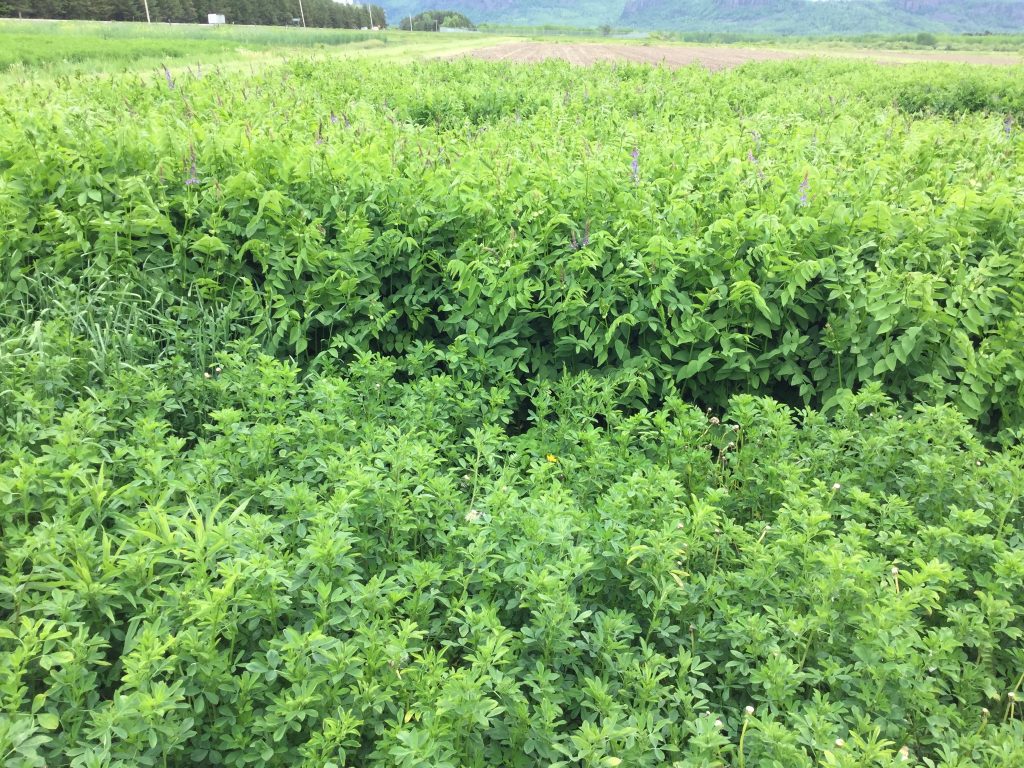
Shown above: Galega (farthest crop shown) takes a stand beside alfalfa (closer crop shown). Note the difference in height.
What is Galega?
Galega (Galega orientalis) is a perennial forage legume from the Scandinavian countries though the plant is reported to be a native of the Caucasus region (located at the border of Europe and Asia, on the peripheries of Turkey, Iran and Russia between the Black and the Caspian seas). It has light green dense canopy, its leaves are larger than alfalfa and its stem is hollow and much softer than alfalfa. Its beautiful violet blue flowers have good quality nectar that attracts honeybees. Gale is the only variety of Galega in cultivation.
Is it better than alfalfa?
Yes! Galega;
- Gives nearly 1 MT/ha/year higher dry matter yield than alfalfa.
- It has higher protein content than alfalfa in the first cut. If alfalfa has 20-22 % protein Galega will have 24-26 % protein. However, in the second cut the protein content in alfalfa and Galega is the same.
- Is also rich in carotenes, minerals and vitamins, especially vitamin C. It is low in toxic alkaloids. Unlike alfalfa, it has no bloat problem when fed green to livestock.
- Feed quality in Galega, due to its dense and long retained canopy and relatively softer stem (that makes it more palatable) doesn’t come down as quickly as in alfalfa after the first bloom (due to delay in harvesting). Thus overall, it makes a very good quality feed for livestock, especially for dairy cows.
- Has higher persistence than alfalfa that often becomes poor in stand and strength after 3-4 years. Galega plots seeded by us in 2011 at the Thunder Bay Agricultural Research Station (TBARS), Thunder Bay are still having a dense stand, whereas the adjoining alfalfa plots have thinned out. In its natural stands (forest meadows), Galega has been reported to persist for 10-30 years!
- Can smother tough weeds such as dandelions.
- Is more winter hardy than alfalfa. Alfalfa is usually killed by a killing frost, whereas Galega would survive at that low temperature!
- Is early to grow in the spring and its growth rate is faster than alfalfa. As a result, Galega is ready for first cut a week earlier than alfalfa.
- During 2006-’09 and 2011-’17 we didn’t notice any insect pest or disease in Galega. Alfalfa, as we all know, isn’t free of insect pests and diseases.
Any other plus point of Galega?
- It could be used for bioremediation of oil polluted soils; some of the bacteria hosted by Galega could degrade pollutants such as toluenes.
- Galega could also produce good amounts of biogas especially if mixed with grasses and manure.
- Galega (flowers) could be a delight to the gardeners.
Any down side?
Galega isn’t good at taking competition from weeds or companion crops in its early establishment stage. Weeds can over grow Galega even though its ability to compete with weeds improves with the canopy development and it will survive under weedy.

